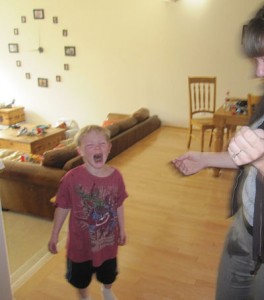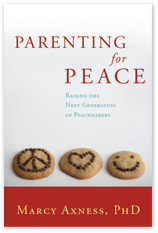 So there you are one afternoon, at the end of your rope with an out-of-control three-year-old. You know you won’t spank him, and you have become mindful of avoiding shame-based measures, so what’s left? Is “Time Out” the answer? At risk of bringing on the wrath of parents everywhere, my answer is no. Time-outs were conceived as a more humane alternative to spanking, but the problem is, they land a blow to the brain and psyche rather than to the bottom.
So there you are one afternoon, at the end of your rope with an out-of-control three-year-old. You know you won’t spank him, and you have become mindful of avoiding shame-based measures, so what’s left? Is “Time Out” the answer? At risk of bringing on the wrath of parents everywhere, my answer is no. Time-outs were conceived as a more humane alternative to spanking, but the problem is, they land a blow to the brain and psyche rather than to the bottom.
Right at the moment when the child is overwhelmed by a flood of emotions he cannot manage, and he most needs the regulating presence — that is, close physical presence — of his attachment figure, he’s banished to his room or his “Naughty Chair” or his “Thinking Rug” or his [fill in the blank with any of a list of prettied-up names people have devised for this particular form of exile]. (more…)
 A big pet peeve of mine is the label “attachment disorder.” This is a diagnosis given to kids who have typically experienced severe disruption in the natural order of what should have been the effortless, instinctual connection we’re designed to make from the very beginning. They were prepared at the level of their brains, their hormones and their entire sensing organism to connect, to be skin-to-skin with oxytocin flowing and weaving the powerful bonding foundations for healthy attachment. They expected to connect.
A big pet peeve of mine is the label “attachment disorder.” This is a diagnosis given to kids who have typically experienced severe disruption in the natural order of what should have been the effortless, instinctual connection we’re designed to make from the very beginning. They were prepared at the level of their brains, their hormones and their entire sensing organism to connect, to be skin-to-skin with oxytocin flowing and weaving the powerful bonding foundations for healthy attachment. They expected to connect. I write a lot about the central role of healthy attachment for child wellbeing. But what IS attachment and how do you get it?? It can be easy for someone like me who is steeped daily in the topic to take it for granted that people know what we mean when we say “attachment.” And as developmental psychologist author Gordon Neufeld has pointed out, attachment is not an intuitive word — in other words a word whose meaning is naturally and easily understood.
I write a lot about the central role of healthy attachment for child wellbeing. But what IS attachment and how do you get it?? It can be easy for someone like me who is steeped daily in the topic to take it for granted that people know what we mean when we say “attachment.” And as developmental psychologist author Gordon Neufeld has pointed out, attachment is not an intuitive word — in other words a word whose meaning is naturally and easily understood.

